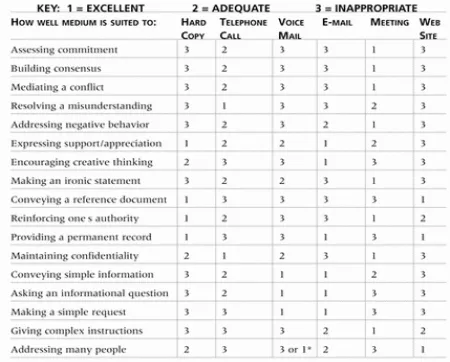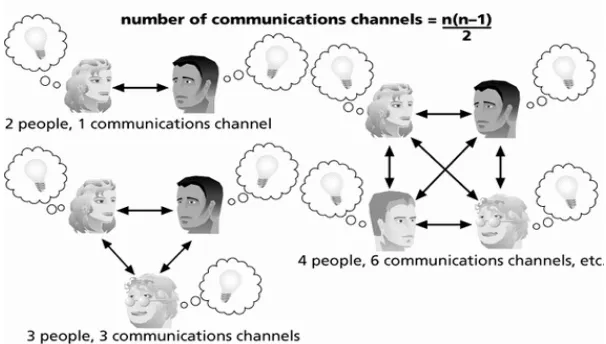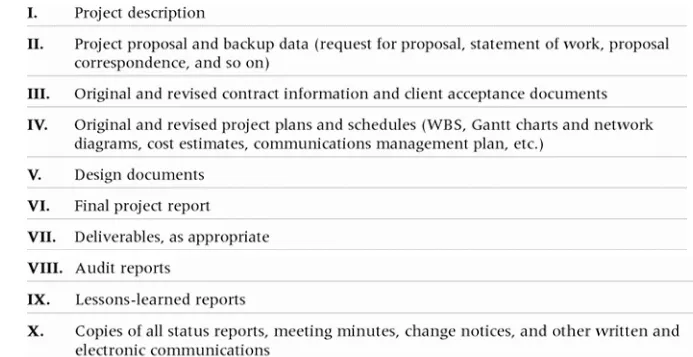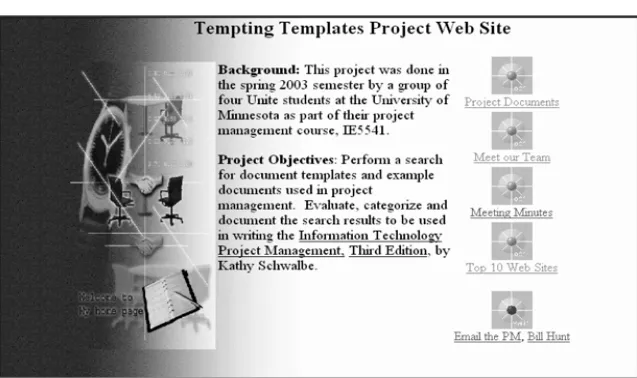Project Communications
Management Processes
Communications planning: Determining the information and communications needs of the stakeholders.
Information distribution: Making needed information available to project stakeholders in a timely manner.
Performance reporting: Collecting and disseminating
performance information, including status reports, progress measurement, and forecasting.
Managing stakeholders: Managing communications to satisfy the needs and expectations of project stakeholders and to
Communications Planning
Every project should include some type of
communications management plan, a document that guides project communications.
Creating a stakeholder analysis for project
Communications Management
Plan Contents
Stakeholder communications requirements.
Information to be communicated, including format, content, and level of detail.
The people who will receive the information and who will produce it.
Communications Management
Plan Contents (cont’d)
Frequency of communication.
Escalation procedures for resolving issues.
Revision procedures for updating the communications management plan.
Information Distribution
Getting the right information to the right people at the right time and in a useful format is just as important as developing the information in the first place.
Important considerations include:
Using technology to enhance information distribution.
Distributing Information in an
Effective and Timely Manner
Don’t bury crucial information.
Don’t be afraid to report bad information.
Importance of Face-to-Face
Communication
Research says that in a face-to-face interaction:
58 percent of communication is through body language.
35 percent of communication is through how the words are said.
7 percent of communication is through the content or words that are spoken.
Pay attention to more than just the actual words someone is saying.
Encouraging More Face-to-Face
Interactions
Short, frequent meetings are often very effective in IT projects.
Stand-up meetings force people to focus on what they really need to communicate.
Understanding Group and Individual
Communication Needs
People are not interchangeable parts.
As illustrated in Brooks’ book The Mythical Man-Month,
you cannot assume that a task originally scheduled to take two months of one person’s time can be done in one
month by two people.
Personal Preferences Affect
Communication Needs
Introverts like more private communications, while extroverts like to discuss things in public.
Intuitive people like to understand the big picture, while sensing people need step-by-step details.
Thinkers want to know the logic behind decisions, while feeling people want to know how something affects them personally.
Other Communication
Considerations
Rarely does the receiver interpret a message exactly as the sender intended.
Geographic location and cultural background affect the complexity of project communications.
Different working hours
Language barriers
Setting the Stage for Communicating
Bad News
Dear Mom and Dad, or should I say Grandma & Grandpa,
Yes, I am pregnant. No, I’m not married yet since Larry, my boyfriend, is out of a job. Larry’s employers just don’t seem to appreciate the skills he has learned since he quit high school. Larry looks much younger than you, Dad, even though he is three years older. I’m quitting college and getting a job so we can get an apartment before the baby is born. I found a beautiful
apartment above a 24-hour auto repair garage with good insulation so the exhaust fumes and noise won’t bother us.
I’m very happy. I thought you would be too. Love, Ashley
Determining the Number of
Communications Channels
As the number of people involved increases, the
complexity of communications increases because there are more communications channels or pathways through which people can communicate.
Number of communications channels = n(n-1)
2
Performance Reporting
Performance reporting keeps stakeholders informed about how resources are being used to achieve project
objectives.
Status reports describe where the project stands at a specific point in time.
Progress reports describe what the project team has accomplished during a certain period of time.
Managing Stakeholders
Project managers must understand and work with various stakeholders.
Need to devise a way to identify and resolve issues.
Two important tools include:
Expectations management matrix
Suggestions for Improving Project
Communications
Manage conflicts effectively.
Develop better communication skills.
Run effective meetings.
Use e-mail effectively.
Conflict Handling Modes
1. Confrontation: Directly face a conflict using a problem-solving approach.
2. Compromise: Use a give-and-take approach.
3. Smoothing: De-emphasize areas of difference and emphasize areas of agreement.
4. Forcing: The win-lose approach.
Conflict Can Be Good
Conflict often produces important results, such as new ideas, better alternatives, and motivation to work harder and more collaboratively.
Groupthink: Conformance to the values or ethical
standards of a group. Groupthink can develop if there are no conflicting viewpoints.
Research suggests that task-related conflict often
Developing Better Communication Skills
Companies and formal degree programs for IT
professionals often neglect the importance of speaking, writing, and listening skills.
As organizations become more global, they realize they must invest in ways to improve communication with people from different countries and cultures.
Running Effective Meetings
Define the purpose and intended outcome of the meeting.
Determine who should attend the meeting.
Provide an agenda to participants before the meeting.
Prepare handouts and visual aids, and make logistical arrangements ahead of time.
Run the meeting professionally.
Using E-Mail Effectively
Make sure that e-mail is an appropriate medium for what you want to communicate.
Be sure to send the e-mail to the right people.
Use meaningful subject lines.
Using E-Mail Effectively (cont’d)
Limit the number and size of attachments.
Delete e-mail you don’t need, and don’t open e-mail if you question the source.
Make sure your virus software is current.
Respond to and file e-mails quickly.
Using Templates for Project
Communications
Many technical people are afraid to ask for help.
Providing examples and templates for project communications saves time and money.
Organizations can develop their own templates, use some provided by outside organizations, or use samples from textbooks.
Lessons Learned Reports
The project manager and project team members should each prepare a lessons-learned report.
A reflective statement that documents important things an individual learned from working on the project.
The project manager often combines information from all of the lessons-learned reports into a project summary
Project Web Sites
Many project teams create a project Web site to store important product documents and other information.
Developing a Communications
Infrastructure
A communications infrastructure is a set of tools, techniques, and principles that provide a foundation for the effective transfer of information.
Tools include e-mail, project management software, groupware, fax
machines, telephones, teleconferencing systems, document management systems, and word processors.
Techniques include reporting guidelines and templates, meeting ground rules and procedures, decision-making processes, problem-solving approaches, and conflict resolution and negotiation techniques.
Using Software to Assist in Project
Communications
There are many software tools to aid in project communications.
Today more than 37 percent of people telecommute or work remotely at least part-time.
Project management software includes new capabilities to enhance virtual communications.





